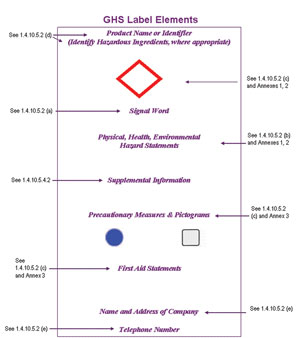The three major areas of change are in hazard classification, labels and safety data sheets.
Hazard classification: The definitions of hazard have been changed to provide specific criteria for classification of health and physical hazards, as well as classification of mixtures. These specific criteria will help to ensure that evaluations of hazardous effects are consistent across manufacturers, and that labels and safety data sheets (SDS) are more accurate as a result.

|
| The Section numbers refer to the sections in the GHS Document or "Purple Book." |
Labels: Chemical manufacturers and importers will be required to provide a label that includes a harmonized signal word, pictogram and hazard statement for each hazard class and category. Precautionary statements must also be provided.
Safety Data Sheets: Will now have a specified 16-section format.
While full compliance with the rule will begin in 2015, OSHA is requiring that employees are trained on the new label elements (i.e., pictograms, hazard statements, precautionary statements and signal words) and SDS format by December 1, 2013. Is your company on track to meet this December deadline?
Why train now?
Many American and foreign chemical manufacturers have already begun to produce HazCom 2012/GHS-compliant labels and SDSs. OSHA says it is important to ensure that when employees begin to see the new labels and SDSs in their workplaces, they will be familiar with them, understand how to use them, and access the information effectively. The sooner you start training your workers, the more prepared your workers will be for these changes.
The updated HCS also stipulates that employers must provide additional employee training for newly identified physical or health hazards by June 1, 2016.
Who should be trained?
The GHS states in Chapter 1.4, Section 1.4.9, the importance of training all target audiences to recognize and interpret label and/or SDS information, and to take appropriate action in response to chemical hazards. Training requirements should be appropriate for and commensurate with the nature of the work or exposure. Key target audiences include workers, emergency responders and also those responsible for developing labels and SDSs. To varying degrees, the training needs of additional target audiences have to be addressed. These should include training for persons involved in transport and strategies required for educating consumers in interpreting label information on products that they use.
What are the GHS label elements?
Some GHS label elements have been standardized (identical with no variation) and are directly related to the endpoints and hazard level. Other label elements are harmonized with common definitions and/or principles. (See Figure above.)
Symbols (hazard pictograms), signal words and hazard statements have all been standardized and assigned to specific hazard categories and classes, as appropriate. This approach makes it easier for countries to implement the system and should make it easier for companies to comply with regulations based on the GHS. Prescribed symbols, signal words and hazard statements can be readily selected from Annex 1 of the GHS “Purple Book.” These standardized elements are not subject to variation and should appear on the GHS label as indicated in the GHS for each hazard category/class in the system.
What is the GHS Safety Data Sheet (SDS)?
The (Material) Safety Data Sheet (SDS) provides comprehensive information for use in workplace chemical management. Employers and workers use SDSs as sources of information about hazards and to obtain advice on safety precautions.
The SDS should contain 16 headings. The GHS MSDS headings, sequence and content are similar to the ISO, EU and ANSI MSDS/SDS requirements, except the order of sections 2 and 3 have been reversed. The SDS should provide a clear description of the data used to identify the hazards. The GHS Purple Book provides the minimum information required in each section of the SDS. The revised Purple Book contains guidance on developing a GHS SDS (Annex 4). Other resources for SDSs include:
- ILO Standard under the Recommendation 177 on Safety in the Use of Chemicals at Work
- International Standard 11014-1 (1994) of the International Standard Organization (ISO) and ISO Safety Data Sheet for Chemical Products 11014-1: 2003 DRAFT
- American National Standards Institute (ANSI) Standard Z400.1
- European Union SDS Directive 91/155/-EEC
Minimum training requirements
The list below contains the minimum required topics for the training that must be completed by the December 1, 2013, deadline:
Training on label elements must include information on:
- Type of information the employee would expect to see on the new labels, including the
Product identifier: how the hazardous chemical is identified. This can be (but is not limited to) the chemical name, code number or batch number. The manufacturer, importer or distributor can decide the appropriate product identifier. The same product identifier must be both on the label and in Section 1 of the SDS (Identification).
Signal word: used to indicate the relative level of severity of hazard and alert the reader to a potential hazard on the label. There are only two signal words, “Danger” and “Warning.” Within a specific hazard class, “Danger” is used for the more severe hazards and “Warning” is used for the less severe hazards. There will only be one signal word on the label no matter how many hazards a chemical may have. If one of the hazards warrants a “Danger” signal word and another warrants the signal word “Warning,” then only “Danger” should appear on the label.
Pictogram: OSHA’s required pictograms must be in the shape of a square set at a point and include a black hazard symbol on a white background with a red frame sufficiently wide enough to be clearly visible. A square red frame set at a point without a hazard symbol is not a pictogram and is not permitted on the label. OSHA has designated eight pictograms under this standard for application to a hazard category.
Hazard statement(s): describe the nature of the hazard(s) of a chemical, including, where appropriate, the degree of hazard. For example: “Causes damage to kidneys through prolonged or repeated exposure when absorbed through the skin.” All of the applicable hazard statements must appear on the label. Hazard statements may be combined where appropriate to reduce redundancies and improve readability. The hazard statements are specific to the hazard classification categories, and chemical users should always see the same statement for the same hazards, no matter what the chemical is or who produces it.
Precautionary statement(s): means a phrase that describes recommended measures that should be taken to minimize or prevent adverse effects resulting from exposure to a hazardous chemical or improper storage or handling.
Name, address and phone number of the chemical manufacturer, distributor or importer
- How an employee might use the labels in the workplace. For example,
- Explain how information on the label can be used to ensure proper storage of hazardous chemicals.
- Explain how the information on the label might be used to quickly locate information on first aid when needed by employees or emergency personnel.
- General understanding of how the elements work together on a label. For example,
- Explain that where a chemical has multiple hazards, different pictograms are used to identify the various hazards. The employee should expect to see the appropriate pictogram for the corresponding hazard class.
- Explain that when there are similar precautionary statements, the one providing the most protective information will be included on the label.
Training on the format of the SDS must include information on:
- Standardized 16-section format, including the type of information found in the various sections
- For example, the employee should be instructed that with the new format, Section 8 (Exposure Controls/Personal Protection) will always contain information about exposure limits, engineering controls and ways to protect yourself, including personal protective equipment.
- How the information on the label is related to the SDS
- For example, explain that the precautionary statements would be the same on the label and on the SDS.
Language barriers & limitations
As referenced in OSHA chief Dr. David Michaels’ OSHA Training Standards Policy Statement (April 28, 2010), with all training, OSHA requires employers to present information in a manner and language that their employees can understand. If employers customarily need to communicate work instructions or other workplace information to employees in a language other than English, they will also need to provide safety and health training to employees in the same manner. Similarly, if the employee’s vocabulary is limited, the training must account for that limitation. By the same token, if employees are not literate, telling them to read training materials will not satisfy the employer’s training obligation.
Resources
OSHA’s Hazard Communication website (http://www.osha.gov/dsg/hazcom/index.html) has QuickCards, OSHA Briefs and other resources to assist employers with the required training.


